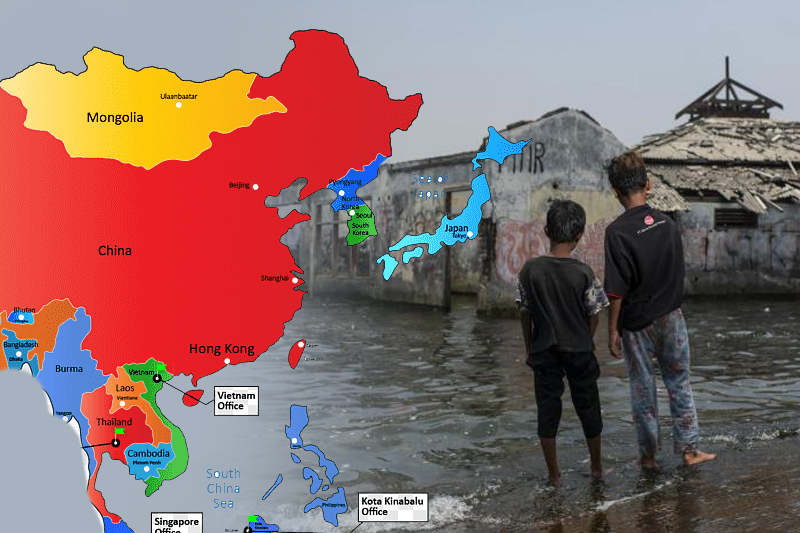
Children In East Asia And Pacific: Coping With Climate Shocks And Inequality
In East Asia and the Pacific region, children are more exposed to the risks of climate change and environmental hazards than in any other region. The increasing frequency and intensity of climate-related disasters are eroding their coping capacity, exacerbating inequality, and forever changing their futures. This article will discuss the various climate and environmental shocks children in the region face, their impact on coping strategies and inequality, and potential solutions to address these challenges.
Climate Shocks In East Asia And Pacific Region
Multiple And Overlapping Hazards
Children in the East Asia and Pacific region are experiencing multiple, often overlapping climate and environmental hazards and shocks. According to UNICEF’s latest regional report ‘Over the Tipping Point,’ they face a six-fold increase in climate-related disasters compared to their grandparents.
Over the last 50 years, the region has seen:
- 11 times increase in floods
- 4 times increase in storms
- 2.4 times increase in droughts
- 5 times increase in landslides
Rising Temperatures And Sea Levels
With temperatures and sea levels rising, extreme weather events such as typhoons, severe floods, landslides, and droughts are becoming more frequent and intense, putting millions of children at risk.
Children’s Exposure To Climate Shocks
According to the latest analysis based on the Children’s Climate Risk Index (CCRI), in the East Asia and Pacific region:
- There are over 210 million children who are highly exposed to cyclones
- There are 140 million children who are highly exposed to water shortages
- There are 120 million children who are highly exposed to coastal flooding
- There are 460 million children who are exposed to air pollution
Moreover, many children in the region are exposed to more than one type of climate and environmental shock, stress, or hazard:
- 443 million children face 3 or more types of climate shocks (89% vs. 73% globally)
- 325 million children face 4 or more types of climate shocks (65% vs. 37% globally)
- 204 million children face 5 or more types of climate shocks (41% vs. 14% globally)
- 63 million children face 6 or more types of climate shocks (12% vs. 3% globally)
Eroding Coping Strategies
Displacement And Survival Challenges
As a result of these climate shocks, many children and their families face displacement and struggle to survive, with limited or no access to essential services like healthcare, education, water, and sanitation.
Keep Reading
Compounded Crises
When overlapping climate shocks are compounded by other types of crises, such as food insecurity, malnutrition, and the spread of infectious diseases, it becomes hard to cope and recover for the most vulnerable children, particularly those from poor and marginalized communities and those with disabilities.
Exacerbating Inequality
Climate change and environmental challenges are exacerbating existing inequalities among children. The poorest and most vulnerable children are pushed further into poverty, widening the gap between the haves and have-nots.
Impact On Education
Climate-related disasters can lead to school closures, loss of teaching materials, and displacement of teachers and students, disrupting children’s education and diminishing their prospects.
Impact On Health
Children’s health is adversely affected by climate change, with an increased risk of infectious diseases, malnutrition, and mental health issues due to displacement and trauma.
Impact On Water And Sanitation
Water contamination and scarcity brought on by climate change may make it difficult for children to access the clean water and proper sanitation they need for healthy growth and development.
Addressing Climate Shocks And Inequality
Climate-Smart Social Services
Governments, corporations, and donors are being urged by UNICEF to take swift action and commit funds to the development of social services that are climate-smart, such as:
Education:
Ensuring that schools are built to withstand climate shocks and that curricula incorporate climate change education
Healthcare:
Strengthening health systems to cope with climate-related health risks and ensuring access to healthcare services for displaced children
Water supply and sanitation:
Investing in resilient water and sanitation infrastructure and promoting water conservation and management practices
Early Warning Systems
Implementing early warning systems can help communities prepare for and respond to climate-related disasters, minimizing their impact on children and their families.
Climate-Responsive Social Protection
Governments should adopt climate-responsive social protection measures, such as cash transfers, to help vulnerable families cope with the impacts of climate change and reduce inequality.
Disaster Risk Management
Governments, businesses, and donors should address critical bottlenecks in disaster risk management and adopt climate-smart services to protect children from the impacts of climate change.
Ensuring A Sustainable Future
Climate change and environmental challenges threaten the sustainable development and economic growth of East Asia and the Pacific region, with lifelong and irreversible impacts on the lives and livelihoods of children and young people. Stakeholders must work together to address these challenges and protect children’s right to survive and thrive in a safe and healthy environment.




